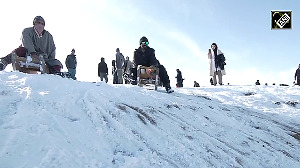Disasters like Saki Naka landslide, which claimed over 75 lives in the torrential rains last week, could have been avoided had the Brihanmumbai Municipal Corporation authorities heeded to the disaster management expert committee's warning and taken stern action against those who made the heavily quarried hillock as their homes, experts said.
"We had warned the BMC about possible places of landslides during the monsoons in the city. Saki Naka (in north Mumbai) was listed as one of the sites for possible landslides," member of the BMC's expert committee V Subramaniyan told PTI in Mumbai on Wednesday.
"Landslides in a coastal city like Mumbai and that too in residential areas are entirely due to anthropogenic activities," Subramaniyan, a retired professor of Engineering Geology of the Indian Institute of Technology, Mumbai, said.
"Slopes of these hills in Mumbai are perfectly stable. No landslide will occur if they are not disturbed," he said adding, "but stone quarries are opened up on these slopes at many places, cutting them into vertical faces."
This destabalises the hill slopes, removing the basal support for the rock blocks that occur above, he said.
The geological set-up of Mumbai is such that the black basalt rock has a westerly inclination called 'dip' and so the hills have accordingly a long slope to the west at moderate angles of upto 15 degrees, Subramanyan said.
"The opposite side -- easterly slopes -- of these hills are short and steep. Utilising the cracks that are present, rock slides occur on the eastern side when there is a heavy downpour," Subramaniyan pointed out.
"This was how a major landslide occurred on the southern slopes of the hill at Chiragnagar in Ghatkopar (W) on July 13, 2000, leading to the death of about 70 people who had built hutments below the hill on the abandoned quarry floor," he said.
The expert committee had pointed out that landslides can be predicted and prevented altogether and suggested many measures to stabilise the hill slopes, he said.
The measures included driving rock bolts, construction of retaining walls below the slopes, spraying cement mixture over the hill slopes, putting steel wire nets over the slopes and supporting loose boulders with brackets.
The committee had also suggested prohibiting quarrying altogether in residential areas and permitting such activities in remote areas where sufficient rock is available.
"But these suggestions were not heeded to and the landslides continue to take a heavy toll almost every year," the committee members had observed.
One important appeal to the authorities was to declare at least 20 mt around the hills in Mumbai as landslide-prone areas and see that no hutments come up within this zone, the member said.
The Slum Improvement Board of the Maharashtra Housing and Areas Development Authority has been taking preventive measures like constructing retaining walls over the years. But they have a limited budget, which is not adequate for the job, Subramaniyan added.






 © 2025
© 2025